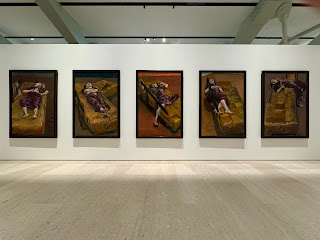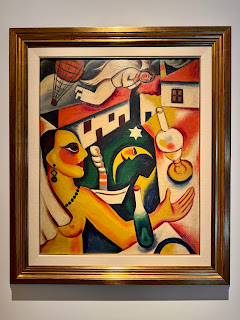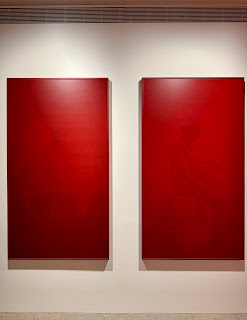CAM Gulbenkian (May 19th)
The Centro de Arte Moderna has a new show, "Paula Rego e Adriana Varejão – Entre os vossos dentes" (Between Your Teeth). The renovated CAM is still in its first year since re-opening, so we are curious to revisit and see how CAM's staff turns over its installations. The show's two artists are Paula Rego, who we know very well, and Adriana Varejão, who is new to us. The exhibition is arranged in a series of partitioned 'temas' (themes), with the subtitles listed below …
"Memórias de açúcar e sal" (Memories of Sugar & Salt)
Rego's "Vasto mar de sargaços" (2000) faces the entrance to the first tema'; it includes a large canvas and a smaller 'predella'. The images illustrate the novel Wide Sargasso Sea (Jean Rhys, 1996), a prequel to Jane Eyre (Charlotte Brontë, 1847) which re-contextualizes the character of Bertha Mason, the 'hysterical' woman locked in the attics of Mr Rochester's manor and who later sets the house ablaze (note the burning tree beside the house).
Varejão's "Passagem de Macau a Vila Rica"(1992) places Portuguese churches atop the mountains of an old Chinese ink painting, as well as a mill in the valleys of Brazil, plus a blob of paint that looks as if she dropped the dripping heart of an animal on the surface. This sets up a series of twists in which we are made to rethink familiar visual tropes, often involving the subjugation and violence Portugal's colonial dictatorship.
"Comemos, dançamos, matamos e misturamos" (We Eat, Dance, Kill & Mix)
Though built as separate 'islands', the openings between the temas suggest a path. Varejão's "Tintas Polvo" (2013) and "Polvo Color Wheels" (2018) dominate the next space. The Wheels look like experiments in color until we read the names (a sampler):
Branquinha – Snow WhiteCabocla – Half BreedMorenao – Big Black DudeMulatinha – Sweet Mulatto MissPolaca – Polack
Rego's "Mãe" (1997, no photo) and "Carga Humana" (2008) are on the side and facing walls and give these colors a human presence and narrative life.
"Apesar de você" (In Spite of You)
Varejão's 'bloody' wall papers serve as a background for Rego's "A sina de Madame Lupescu" (2004) and "Salazar a vomitar a Pátria" (1960).
"Mar, onde sou a mim mesma devolvida em sal, espuma e concha" (The Sea Where I Am to Myself Given Back in Salt, Foam, & Shell)
Rego's "Sirenas voladoras" (2017) fly overhead; they are haunting mermaids with dark, battered wings and toothless faces. Around the room, Varejão's over-sized chargers, such as "Mãe d'Água" (2009), "Prato con mariscos" (2011), and "Ama Divers" (2011) make offerings of seafood and fruit, as well as the people who harvest them.
Varejão's "Pérola Imperfeita"(2009), with its bright yolk and divers in the translucent egg whites, is next to Rego's "O Pescador" (2005), a monstrous angler wearing a grotesque 'minstrel' mask.
Rego's "Figo" (Fábrica de Faianças Artísticas Bordallo Pinheiro, 2017) is on the other side of the doorway; it is a recreation of a plush sculpture executed in ceramics. The 'biology' is recreated in astonishing detail.
"Faca amolada" (Sharpened Knife)
The tile wall in Varejão's "Parede com Incisões à la Fontana" (2002) is cut open like the spent set of a slasher movie. The perpetrator appears to be Rego's "Anjo" (1998), with her enormous blade, cleaning sponge, and petrifying smile.
"Rituais de limpeza" (Cleansing Rituals)
The smaller, more intimate images are just as terrifying. Varejão's "A malvada" (2009) provides more evidence of evil, again, without naming the deed. And Rego's "Sem Título Nº 7" (1999) shows the deed, while letting us fill in the title.
"Câmara de ecos" (Echo Chamber)
In Varejão's "O Sedutor"(2004), we are invited to step into the tiled washroom, unsure if we are too late – or worse, too soon.
"Corpo em transe" (Body In Trance)
In Rego's "Possessão" (2004), we feel the psychological damage as a patient struggles to sit still in five nearly life-sized drawings.
"Fui terra, fui ventre, fui vela rasgada" (I Was Land, a Womb, a Torn Sail)
We finish in another room like "Apesar de você", covered with Varejão's papel de parede (the web site suggests this room as the show's starting point). Rego's "A primeira missa no Brasil" (1993) depicts the arrival of the Portuguese in Brazil, but focuses on the pregnant woman, wide-eyed in anticipation and fear, and gesturing to the Cross. While Varejão's "Mapa de Lopo Homen II" (1992-2004) attempts to stitch the wounds but cannot heal them.
The show is veracious, almost brutally so – maybe not the best for a relaxing day of art, but the artistic and curatorial storytelling is urgent and powerful.
To take the edge off, we wander across the garden to the Museu to see "Arte Britânica – Ponto de Fuga", a retrospective of British art from the last century. The show has an easy energy and explores the figural, the abstract, and the liminal; it includes many favorite artists (even Rego, who worked in London) …
For example, "Picture Emphasizing Stillness" (David Hockney, 1962) and the series "Konstruktion [Kestnermappe 6]" (Lászlo Moholy-Nagy, 1922-23) both display an ethereal balance of diagonal motions to very different effects.
In the same way, "Rudol 333" (Kurt Schwitters, 1939) and "The Vivian Girls as Windmills" (Paula Rego, 1984) offer two ways to express a churning, swirling playfulness.
Finally, "Dokumentarfilm [Doshi, 12. April 2003, 13.34 Uhr]" (João Penalva, 2004) and "School - Classroom" (Mark Wallinger, 1990) present empty spaces where enigmatic light seems to animate the stillness. If that's a projector lamp, we must be the show.
MACAM (June 2nd)
The Museu de Arte Contemporânea Armando Martins is housed in the recently renovated Palácio dos Condes de Vila Franca (early 18th century).
The Permanent Collection fills the two wings of the Palácio; the Museu describes this as "Uma coleção a dois tempos" (a collection in two stages) …
"Arte Moderna Portuguesa"
The first gallery begins with the early days of the República Portuguesa and the Estado Novo aligning with the entreguerras. These painting give us a flavor of the places and people that carried the optimism of that time. "Música Surda" (Amadeo de Souza-Cardoso, 1914-15) offers hints of Cubism and Fauvism. "Diligência no Terreiro do Paço" (José de Almada Negreiros, c1938) is an Art Deco influenced study for a mural of a stagecoach disembarking at an arcade on the Praça dos Restauradores.
The "Sinfonia da Tarde" (Júlio dos Reis Pereira, 1924) and "As Três Graças" (Sarah Affonso, 1930) extend the collection's stylistic reach into Expressionism and Primitivism; yet both pieces reflect the influence of Portuguese arte popular (folk art).
The "Páteo de D. Fradique" (Carlos Botelho, 1946) and "Le Retour d'Adonis" (Manuel Cargaleiro, 1972) bring us to the end of the dictatorship and are deeply personal interpretations of essential Portuguese imagery: the Páteo near the Castelo de São Jorge and the ever-present patterns of azulejos.
On a prominent end wall and with precisely shuttered lighting, "Maio de 68" (Maria Helena Vieira da Silva, 1968, top image) marks our arrival in the abstract. Its disposition is gritty and urban, but with a sense of twilight or maybe sunrise.
"Fernando Pessoa" (Júlio Pomar, 1985) and "As Três Graças [Naked Lunch #35]" (Miguel Branco, 2019) deliver us into the present day with dazzling color and light. The Graças provide a glittering and grisly echo to Afonso's trio and dance under the dome of the Palácio's old bread oven.
"Arte Contemporânea Nacional e Internacional"
The "Casa Luis Barragan 3" (Juan Araujo, 2010) reconnects to the liminal sensibility from the Arte Britânica show: a painting of a photo printed in a book, between inside and out, with dappled sunlight, and an Albers 'Square' painting. A searing haze overwhelms "São Paulo #1" (from the series "Rua Stan Getz", André Cepeda, 2012), as if we are microscopically zoomed into the Albers.
The leafy shade and intense heat prepare us for the next room, where we spend quite a long time with "Wildfire [Meditation on Fire]" (David Claerbout, 2019-2020, sample here). It's a singular piece that ought to be experienced live and at scale (video from Kunstmuseum Winterthur, 2020) – equal parts meditative and horrifying.
Wildfire (Meditation on Fire ) at Kunstmuseum Winterthur 2020, Studio David Claerbout
Rego's "The Knight, the Lady and the Priest 2" (Paula Rego, 1984) gives more connective material; in Rego's oeuvre, this series follows the "The Vivian Girls" from Arte Britânica. "Untitled [two stones]" and "Untitled [lion king]" (from "Red Series [Military]", Rosângela Rennó, 2000 and 2000-2003) take those flat red graphics, and the vague religious and military 'shadows' in a different direction.
"Paisagem Nº77" (Lucia Laguna, 2014) bring elements of the cityscape into the gallery. While "There is always Something More Important" (Mariele Neudecker, 2012) and "Blossom #8" (Pedro Cabrita Reis, 2024) spill into the courtyard between the Museu and the Hotel. The Hotel also features a stunning, ceramic brise soleil by Maria Ana Vasco Costa.
After a casual lunch in the Hotel's cafe, we depart the Palácio and cross the street. From this side, we can see that the Hotel's elevated outdoor spaces contain more large sculptures, the "Pilha Pesada de Cinco Metais" (Angela Bulloch, 2024) and "Untitled" (José Pedro Croft, 2023).
Hearing about this complex, a hotel and a museum, we expect to find a little gallery off the lobby. But this is an impressive collection, professionally presented, and as substantial as the palace. It's a concise but complete retrospective of twentieth and twenty-first century art, with a unique lens on and from Portugal.







































